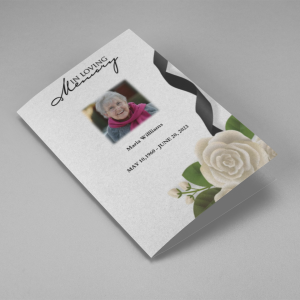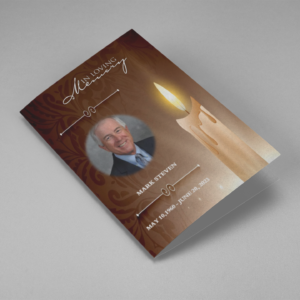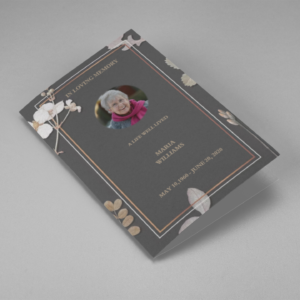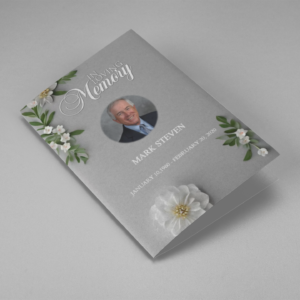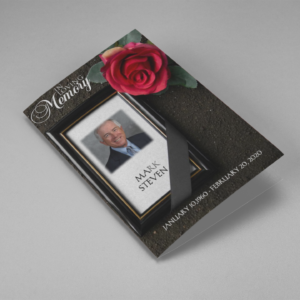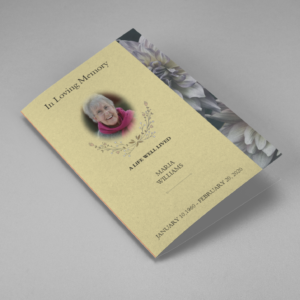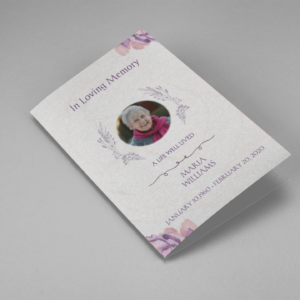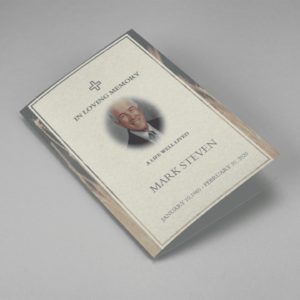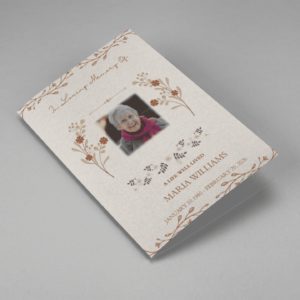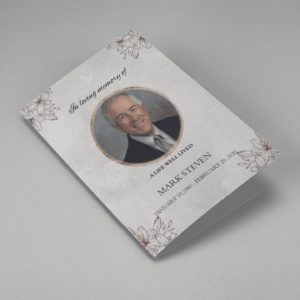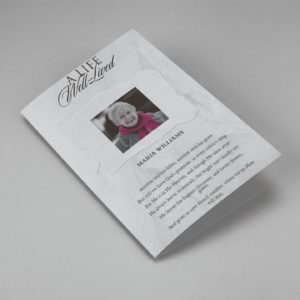Note that there are two types of embalming, “unautopsied” and “autopsied.” Modem embalming consists of using the circulatory system of the body to inject chemicals that retard decomposition, increase sanitation, and provide cosmetic benefits. The solution is injected through an opening made in an artery and the blood it replaces is drained from a vein. The solution consists of a formaldehyde base with various additives to help the cosmetic results. A small surgical incision is made at what a layman would call a “pressure point,” where the vessels are near the surface of the skin. The body cavity is treated by inserting a surgical tube known as a “tracer” through the abdomen so that the solution can saturate the cavity and the organs it contains. All this is true for an unautopsied body. An autopsied body has most likely had the body cavity and/ or the head surgically examined by a pathologist.
Embalming your loved one’s body
- By nitin
- |
- Funeral Program
- |
- 0 Comment
-
Searching for a White Roses And Black Ribbon Funeral Program Template that is easy to print and has a cutting-edge look? White Roses And Black Ribbon Funeral Program Template is the Perfect decision because it measures 8.5”x 11”.
- No Limitation on Content, Edit anything
- Edit anytime – unlimited revisions even after purchased
- Get a printable PDF downloaded to get it printed on your own
-
Searching for a Realistic Burning Candle Funeral Program Template that is easy to print and has a cutting-edge look? Realistic Burning Candle Funeral Program Template is the Perfect decision because it measures 8.5”x 11”.
- No Limitation on Content, Edit anything
- Edit anytime – unlimited revisions even after purchased
- Get a printable PDF downloaded to get it printed on your own
-
Searching for a Bulltongue Arrowhead Funeral Program Template that is easy to print and has a cutting-edge look? Bulltongue Arrowhead Funeral Program Template is the Perfect decision because it measures 8.5”x 11”.
- No Limitation on Content, Edit anything
- Edit anytime – unlimited revisions even after purchased
- Get a printable PDF downloaded to get it printed on your own
-
Searching for a Grey Floral White Tiny Flower Funeral Program Template that is easy to print and has a cutting-edge look? Grey Floral White Tiny Flower Funeral Program Template is the Perfect decision because it measures 8.5”x 11”.
- No Limitation on Content, Edit anything
- Edit anytime – unlimited revisions even after purchased
- Get a printable PDF downloaded to get it printed on your own
-
Searching for a Red Flower Dark Soil Funeral Program Template that is easy to print and has a cutting-edge look? Red Flower Dark Soil Funeral Program Template is the Perfect decision because it measures 8.5”x 11”.
- No Limitation on Content, Edit anything
- Edit anytime – unlimited revisions even after purchased
- Get a printable PDF downloaded to get it printed on your own
-
Searching for a Pink Rose Frame Floral Oval Badge Funeral Program Template that is easy to print and has a cutting-edge look? Pink Rose Frame Floral Oval Badge Funeral Program Template is the Perfect decision because it measures 8.5”x 11”.
- No Limitation on Content, Edit anything
- Edit anytime – unlimited revisions even after purchased
- Get a printable PDF downloaded to get it printed on your own
-
Searching for a Brown and White Classic Funeral Program Template that is easy to print and has a cutting-edge look? Brown and White Classic Funeral Program Template is the Perfect decision because it measures 8.5”x 11”.
- No Limitation on Content, Edit anything
- Edit anytime – unlimited revisions even after purchased
- Get a printable PDF downloaded to get it printed on your own
-
Searching for a Purple Elegant Watercolor Funeral Program Template that is easy to print and has a cutting-edge look? Purple Elegant Watercolor Funeral Program Template is the Perfect decision because it measures 8.5”x 11”.
- No Limitation on Content, Edit anything
- Edit anytime – unlimited revisions even after purchased
- Get a printable PDF downloaded to get it printed on your own
-
Searching for a Cream and Green Photo Obituary Program that is easy to print and has a cutting-edge look? Cream and Green Photo Obituary Program is the Perfect decision because it measures 8.5”x 11”.
- No Limitation on Content, Edit anything
- Edit anytime – unlimited revisions even after purchased
- Get a printable PDF downloaded to get it printed on your own
-
Searching for a Cream Simple Elegant Photo Church Program that is easy to print and has a cutting-edge look? Cream Simple Elegant Photo Church Program is the Perfect decision because it measures 8.5”x 11”.
- No Limitation on Content, Edit anything
- Edit anytime – unlimited revisions even after purchased
- Get a printable PDF downloaded to get it printed on your own
-
Searching for a Grey Classic Minimalist Funeral Program Template that is easy to print and has a cutting-edge look? Grey Classic Minimalist Funeral Program Template is the Perfect decision because it measures 8.5”x 11”.
- No Limitation on Content, Edit anything
- Edit anytime – unlimited revisions even after purchased
- Get a printable PDF downloaded to get it printed on your own
-
Searching for a White Classic Funeral Program Template that is easy to print and has a cutting-edge look? White Classic Funeral Program Template is the Perfect decision because it measures 8.5”x 11”.
- No Limitation on Content, Edit anything
- Edit anytime – unlimited revisions even after purchased
- Get a printable PDF downloaded to get it printed on your own
An autopsy requires more work, time, and chemicals for a funeral director, hence a higher charge. (Price range =$181 to $650*) Sanitary care without embalming is exactly that: sometimes the body is surface disinfected. (Some states do have regulations requiring the embalming of a body that is out of refrigeration for a specific period of time.) This charge is minimal, no standard set, but I would guess $50. “Other” refers to restorative art or the reconstruction of facial features out of necessity. This could be required for an accident victim whom the family wishes to view. The reconstruction is done by the funeral director first using surgical suturing techniques, then an embalmers wax to rebuild features.
The results can be amazing if done by a talented funeral director. (Price range =an hourly rate of from $75 to $200) “Dressing and casketing” means the preparation after embalming to casket the deceased for viewing or for a service. The funeral director can supply clothing, but generally the clothing is more expensive than what a family can provide. The cost of the clothing can be found under “merchandise.” Cosmetic application is necessary for an open casket if the deceased’s appearance is important. (Price range =$57 to $125)
Use of Facilities
This charge is itemized to reflect the actual use of the funeral home. A room is set aside for each family having calling hours. The service can be held in that room or in a chapel set aside just for the service. Charges are based on the length of time the family occupies the room: a one-day viewing instead of two would incur less charge. There is a recent trend toward shorter viewing periods (Price range =$160 to $450 for one day of viewing or service). A viewing period of two hours in the afternoon and another two hours in the evening would be considered one day. The “preparation room” is on overhead charge for where the embalming takes place. (Price range =roughly $100)
Transportation
these potential charges, the first two are non-negotiable. For any handling of the deceased to take place, the body must be transported to the funeral home. Even if there are no services at the funeral home for instance, in the case of immediate cremation-the deceased must still be transported to the place of burial or cremation. One word of caution: A hearse is a specially constructed car designed to hold a single casket. If your funeral arrangements state that you are paying for a hearse, make sure you get one. Vans or station wagons used to take cremation containers in multiples to a crematory are not hearses. Limousines are used to transport a family to the funeral home, the church, or the cemetery. They do provide a convenience to families who do not want to drive or who don’t have their own vehicles.

This item is an obvious place to cut expenses. In arranging for a funeral with cost in mind, paying for a limousine that is not truly needed can be an unwanted expense. Flower cars are used to take the floral arrangements that were with the casket at the funeral home to the place of interment or cremation. Often the consumer cannot decline a vehicle for this purpose, since funeral homes must dispose of the flowers and their containers somehow, and environmental laws and the cost of trash collection can make that difficult. Some churches or nursing homes will take the flowers. (I know of a nursing home that used them for classes in flower arranging.)
An obvious solution is to ask for donations to a charity in lieu of flowers, or the family can take the flower arrangements after the services. These are a few ways to cut expenses. The line marked “other” on the funeral arrangement contract can refer to a car for the clergy or to pick up a relative. It need not be a limousine. Price Ranges Transfer to funeral home Limousine Flower car Other = $75 to $120 = $60 to $160 =$50 to $150 =$50 to $150 These charges are for local trips, usually under twenty-five miles. There are also charges based on mileage for longer trips. Having the interment a significant distance from the funeral home can cost more than the purchase of a new grave locally.

